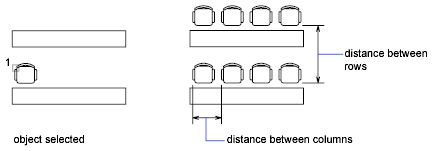You can create copies of objects in a rectangular or polar (circular) pattern called an array.
For rectangular arrays, you control the number of rows and columns and the distance between each. For polar arrays, you control the number of copies of the object and whether the copies are rotated. To create many regularly spaced objects, arraying is faster than copying.

A rectangular array is built along a baseline defined by the current snap rotation angle. This angle is zero by default, so the rows and columns of a rectangular array are orthogonal with respect to the X and Y axes. The default angle 0 direction setting can be changed in UNITS.

When you create a polar array, the array is drawn counterclockwise or clockwise, depending on whether you enter a positive or a negative value for the angle to fill.

The radius of the array is determined by the distance from the specified center point to a reference or base point on the last selected object. You can use the default reference point (usually an arbitrary point that coincides with a snap point), or you can specify a new base point to be used as the reference point.
With 3DARRAY, you can create a rectangular array or a polar array of objects in 3D. In addition to specifying the number of columns (X direction) and rows (Y direction), you also specify the number of levels (Z direction).
If you specify a very large number of rows and columns for an array, it may take a long time to create the copies. By default, the number of array elements that can be generated by one command is limited to approximately 100,000. This limit is controlled by the MaxArray setting in the registry.
You can change the limit by setting the MaxArray system registry variable using (setenv “MaxArray” “n”) where n is a number between 100 and 10000000 (ten million).